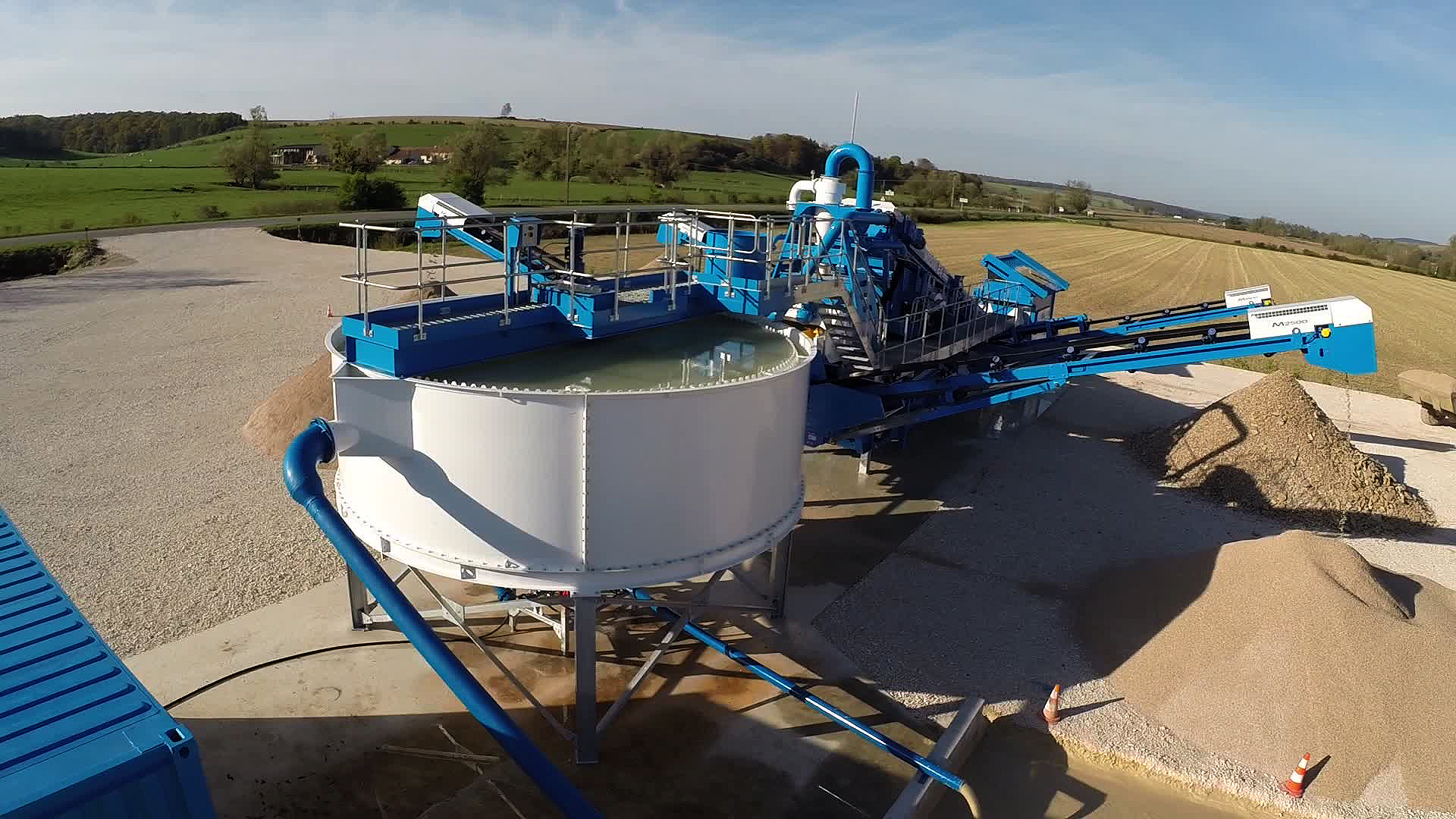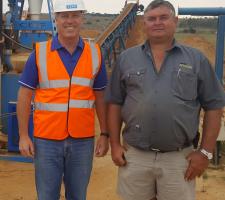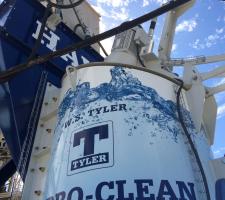
While wet processing is taking an important place in African quarry operators’ portfolios, water restrictions are a reality to contend with, but new washing and water management innovations offer exciting possibilities. Munesu Shoko reports.
Although the sand market constitutes a very large segment of the overall African aggregates industry, the wet processing component has traditionally formed a minimal part of the sector’s materials processing procedures. To put it in context, Nicolan Govender, regional manager Africa at
However, while wet processing remains a small market, all indications are that it has to grow, especially amid the increasing realisation that washing can help quarries improve the quality of their end products, offer added value to end users and help to meet stricter aggregates specifications against a backdrop of taxing operating conditions.
Wayne Warren, business development manager for sub-Sahara Africa at CDE, notes that African quarry operators are increasingly becoming aware of the sand losses they incur through old generation washing plants, as companies continue to seek ways to maximise their return on investment (ROI) in difficult market conditions. As a result, CDE is fast growing its footprint in Africa as sand and aggregates producers are upgrading their installations to reap the benefits of new, innovative wet processing technologies.
To date, CDE’s best sellers in Africa are the Evowash, a wet processing plant that can produce up to two products at the same time, and its water recovery system, the AquaCycle thickener. “With the successes of the EvoWash and AquaCycle, more operators are now choosing the CDE Combo, which comprises both plants. The Combo, with a capacity range of 30 to 200 tonnes per hour, boasts a unique modular design to combine feeding, grading, washing, water recycling and stockpiling onto one compact chassis,” says Warren.
While wet processing is slowly, but surely, becoming an important process in aggregates production, water management is equally a significant priority. Water restrictions, especially on the back of recent drought conditions across regions such as southern Africa, compounded by increasing energy costs in a continent faced with acute energy shortages, translate into difficult operating conditions for aggregate producers.
With such obstacles, Michael Honea, process engineer at
But, thanks to new, leading-edge washing and water management technologies from specialist manufacturers such as CDE, Haver & Boecker and Terex Washing Systems, operators have sound solutions at their disposal to get the better of these operational challenges.
CDE’s AquaCycle technology sets a new era in process water recycling with its ability to recycle up to 90% of used water. Quarries can now make sure that their washing practices do not significantly impact their water consumption, while being able to make the best use of all material extracted from their operations.
“After the raw material has been washed and classified, the processed material is sent to the AquaCycle thickener. In the AquaCycle, a small amount of polyelectrolyte flocculent is added to the water from the automatic closing station which forces fine particles to settle at the bottom of the thickener tank,” says Warren.
The clean water on the top overflows the weir and is stored in the AquaStore tank before being re-circulated around the plant, helping to reduce the amount of required fresh water for top-up down to 10%. The waste sludge is discharged into the buffer tank where a motorised rake in constant rotation ensures the material does not settle and solidify.
With the addition of a CDE Filter Press, a custom-built fines management system, up to 95% of the water can be recycled and the need for settling ponds and tailing dams eliminated. The conventional use of settling ponds has various drawbacks, according to Warren, such as increased downtime while the material settles, as well as the need for extra space on site to accommodate the ponds. “Crucially, we have witnessed on many occasions that high value fines end up as waste, trapped at the bottom of the ponds,” he says.
The reality of a fast ROI becomes very tangible when an AquaCycle thickener is added to a washing operation. It maximises the efficiency of the wet processing plant by increasing the settlement of solids. “This reduces the quantity of flocculent required and running costs, as well as optimising the efficiency of the plant,” Warren explains.
Another key feature of the CDE AquaCycle is that its intelligent design maximises the settlement of solids within the smallest equipment footprint, making it a greater solution for space-restricted sites. Meanwhile, reduced turbulence at the centre of the unit and an integrated FlocStation that doses pre-mixed flocculent allow for rapid settlement.
“High resistance to wear means less downtime; the wedge wire screen removes lightweight contaminants from the recycled water, protecting pumps from blockages,” says Warren, adding that the CDE technology is user-friendly and requires minimum civils work.
Elsewhere, Haver & Boecker’s Hydro-Clean, a high-pressure material washing system ideal for cleaning deleterious material from aggregates, is said to set new washing standards with its ability to reduce water consumption by as much as 75% and energy costs by up to 15% when compared with conventional washing systems such as log washers.
The technology is now available in southern Africa through Haver Southern Africa, a subsidiary of Haver & Boecker established in 2008. Haver Southern Africa supplies, maintains and services the full Haver & Boecker product range throughout the region from its headquarters in Honeydew, Johannesburg, South Africa.
The cleaning of bulk material in the Hydro-Clean high-pressure washing system is done in two processes. Firstly, the feed material passes into the washing drum of the Hydro-Clean, which contains up to two washing rotors, depending on the size. The washing rotors work with rotating, high-pressure water jets which are directed onto raw material with a size of 0-120mm by the rotor nozzles. “This action ploughs through and turns over the raw material. In doing so, the adhering minerals and agglomerates are exposed and the fine content is dispersed and separated with the waste water,” says Jade Edas, sales and marketing manager at Haver Southern Africa.
Secondly, the washed particles are continuously removed by means of a corrugated-edged belt ready for subsequent water spraying and classification. The Hydro-Clean washer comes in three model sizes – the HC350, HC1000 and HC2000 – that produce 18 to 360 tonnes per hour, depending on model and application. Ideal for use in clay-heavy material deposits, the Hydro-Clean is fed dirty material via a hopper into its vertical drum. Once inside, high-pressure nozzles mounted at the top rotate and spray the material with water. Taking feed material as large as 150mm into the vertical drum, the machine’s high-pressure nozzles rotate at 90rpm, using pressures as high as 140 bars to clean the material.
The major benefit of the Hydro-Clean is that it consumes minimal resources. Water consumption ranges from 102 to 800 litres/minute, depending on application and model size. This represents 60% less water circulation compared with traditional washing systems. Choosing this new high-pressure washer at the expense of a conventional log washer, for example, would also reduce energy consumption by as much as 15%. Part of this is due to the speed at which the new washer completes a cycle, according to Edas.
“On average, log washers retain materials for three minutes or more while materials stay in a high-pressure washer drum for just a few seconds,” says Edas. “Beyond low retention time, a high-pressure washer includes sensors that detect the end of each washing cycle to limit wear to the machine from unnecessary use.”
Another big benefit of this machine is less maintenance. It is said to require less maintenance than typical traditional washing systems, such as a log washer. A log washer is said to come with many parts that require regular maintenance, including bearings and belts. Replacing its paddles each year becomes expensive and labour-intensive – sometimes taking as much as four days to complete.
On the other hand, a high-pressure washer is said to only have two wear parts: spray nozzles and valve seals. “A high-pressure washer is easy to maintain because the operator can access the main wear parts through the lid on its drum,” says Edas.
Meanwhile,
Terex’s Water Management Solutions are typically comprised of the following components. A floc dosing plant and thickener tank can be used to recycle up to 80% of the water used in the washing process. The basic method still involves the use of ponds but on a smaller scale as the sludge sent to the ponds is of a much higher specific gravity (1.5 sg). The next stage is to incorporate a filter press which hydrates the thickened sludge even further typically down to 25% moisture. The filter press eliminates the need for ponds as the sludge is hydrated to a material/cake which can be handled by a loading shovel. This cake can be used as a lining or capping material.














